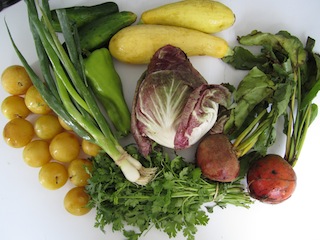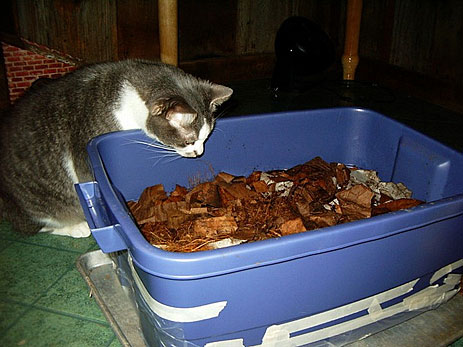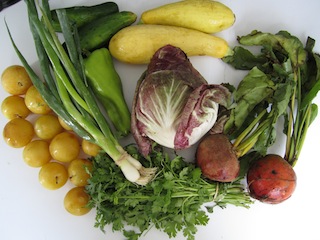 Week 9!Photo: Jennifer PredigerIt’s Week Nine of a takeout eater’s initiation into the delicious world of Community Supported Agriculture, which I’m keeping track of in this Urbivore’s Dilemma series.
Week 9!Photo: Jennifer PredigerIt’s Week Nine of a takeout eater’s initiation into the delicious world of Community Supported Agriculture, which I’m keeping track of in this Urbivore’s Dilemma series.
This week’s CSA box was filled with radicchio, beets, scallions, summer squash, cukes, cilantro, and a sweet pepper. I took it all on my first vacation trip out of the city this summer. Yes, I was that person on the train heading to Fire Island with a tote bag full of vegetables on her lap. This made me think of my great-grandmother riding the old trolley in D.C. with a bag of vegetables on her lap. And the many ancestors before that, all with veggie totes on their laps riding horses and on ships crossing the Atlantic. Oh, how the mind wanders on a vacation.
The beach trip was quick, just two days, which meant eating fast. Summer squash skewer swiftly and are fun on the grill. Taking a swim, I brought a refreshing weekend beverage along with me poolside. Those cucumbers took a dip into a British favorite — Pimm’s and lemonade. Each sip = smooth sailing.
It is high time I thank you, readers, for the great tips for radicchio. Grilling it sounded great. Remaining fearful of the bitterness, I must admit I passed the radicchio buck and left it with my foodworthy friends spending the rest of the week at the beach. I came home with a tan and an empty tote; well, except for the two beets longing to make their debut on my plate. The problem is, I live with a beet-ist. Upon seeing them, he pointed to the trash and said, “They can beat it.”
Since we’re on the subject of trash, even if I were to toss a lovely beet, it wouldn’t feel right just chucking it in a garbage can when one can compost it, and get a return on that rotting. Problem is, I’ve been “freezer composting.” This means I’ve been putting everything I haven’t eaten in time, from that rhubarb that wilted before I got brave enough to use it to those poisonous carrot greens, into plastic bags in the freezer. I’ve been waiting for the time when I’ll know where to take my compost. Not that I expect that information to just come to me.
But composting is not as easy to do in the Big Apple and its surroundings as one might think. A friend of mine read online you could compost at the Brooklyn Botanic Gardens. He brought his coffee grinds and banana peels and was turned away by a security guard who said that announcement had been “a mistake.” With a train ride and smelly garbage in hand, my friend broke the law. He dug a hole nearby and filled it with his compostables. Two tourists came up to ask him questions about the Botanic Garden while he was doing this morally questionable composting.
I don’t need that kind of stress in my life.
Community gardens are supposed to be great places to compost. But my community has no such garden within what appears to be miles on this NYC Compost Green Map. I discovered that the only places I can really compost my food scraps are at two farmers markets. The Union Square market in Manhattan accepts compost four days a week. And there’s a market in Ft. Greene Park in Brooklyn that takes compost, too.
Composting in New York City, it turns out, is more like “vanity composting.” Unless you have a garden or a private yard, there’s really no place for it to go. Farmers can’t use it. They make their own compost, and there’s a concern that city compost might contain contaminated food scraps. Not good when you’re growing healthy, hearty things to eat or sell.
Why doesn’t New York have a municipal compost program? Seattle does. How do they pull off citywide composting?
Thankfully, the Lower East Side Ecology Center uses, accepts, and encourages city compost, but they can only handle so much of the stuff. Maybe to lighten their own compost load, they offer composting classes and encourage vermicomposting! Readers, who among you has or has had a worm bin? What did you think? Should I get a worm bin? Or take the “wormshop” to learn how?
 Everyone’s fascinated with worm bins, it seems.Photo: florence_craye via FlickrI am both comforted by and worried by the fact that they have a “Compost Hot Line” for dealing with “problem solving in the battle against fruit flies and strange smells.” I mean, that sounds serious. Anything that has a hotline for flies and strange smells is maybe not something I want in my life, right?
Everyone’s fascinated with worm bins, it seems.Photo: florence_craye via FlickrI am both comforted by and worried by the fact that they have a “Compost Hot Line” for dealing with “problem solving in the battle against fruit flies and strange smells.” I mean, that sounds serious. Anything that has a hotline for flies and strange smells is maybe not something I want in my life, right?
If I decide to go for the worms, where to put them? Apartment-dwelling worms live in a plastic bin, apparently, just like the ones you can store sweaters in under your bed. Which is good, because in my Brooklyn apartment, under my bed is the only place there’s space. But really, for the sake of restful sleep, what other options are there? The fire escape? I worry they’ll boil out there in the summer and then freeze in winter. Maybe under the kitchen sink?
And is it true worm bins don’t smell? Or is that some dictator worm’s propaganda to get more people to compost? Also, will the worms come out of their bin and crawl around at dinner time?
So many questions! Hopefully some of them will be answered in the composting slideshow we have planned for the Feeding the City series.
At least this is for certain. Next week’s box of edible treasures will include red, yellow, and orange tomatoes! Basil, summer squash or cukes, sweet peppers, fennel, scallion, and sunflowers! Sunflowers?! I’m imagining the thing to do is roast the seeds, but I’m open to ideas.
What’s in your boxes this week? And can you cook and eat a sunflower?
Readers, the stories and ideas you share make the Internet feel like a real connector. Thank you for the ongoing conversation.



